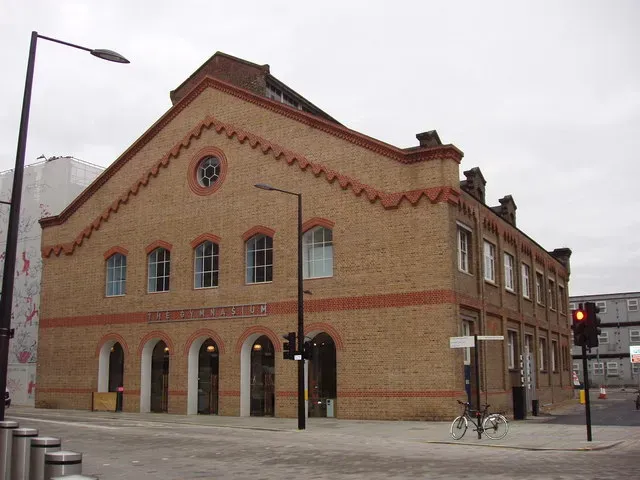Table of Contents
Tired of fighting for equipment at the crowded gym? Or maybe just trying to squeeze a workout into an already packed schedule feels impossible? You're not alone. For many, the idea of getting a solid, full-body workout without leaving the house seems like a dream. Enter the body home gym – a single piece of equipment designed to hit multiple muscle groups, offering a convenient and effective alternative to traditional gyms.
What Exactly is a Body Home Gym?
What Exactly is a Body Home Gym?
More Than Just a Pull-Up Bar
When you hear "body home gym," don't just picture a dusty barbell in the corner or a single pull-up bar bolted to a door frame. We're talking about a system, often a single, integrated piece of equipment designed to provide a comprehensive workout for your entire body. Think of it as condensing several traditional gym machines into one footprint. The goal is simple: offer resistance training for major muscle groups without needing a dedicated room full of individual weights and machines. It’s about efficiency in space and exercise variety rolled into one unit.
Combining Stations for Full Coverage
These setups typically feature multiple "stations" or functions built into a single frame. You might have a weight stack or resistance system connected to cables and pulleys, allowing for exercises like lat pulldowns, triceps pushdowns, and chest presses. Many include a leg extension and curl station, sometimes a pec deck, and often a low pulley for rows and curls. The clever engineering combines these movements so you can flow from one exercise to the next, targeting your upper body, lower body, and core without hopping between disparate pieces of equipment. It’s not quite the same feel as free weights, sure, but the controlled motion can be a solid starting point or a consistent alternative.
- Integrated weight stack or resistance system
- Multiple pulley points (high, mid, low)
- Chest press/pec deck station
- Leg extension/curl attachment
- Often includes attachments like bars, ropes, and handles
Who Needs One of These Anyway?
So, who are these multi-station body home gym systems for? They're often a prime candidate for folks short on space but serious about strength training. They're also a great option for beginners who might feel intimidated by free weights, as the guided movement can feel safer. Plus, for anyone trying to ditch the monthly gym fee or simply save time on commuting, having a versatile system right there in the basement or garage is a significant win. It's not about replicating a massive commercial gym; it's about providing the tools for a balanced, effective strength routine conveniently at home.
Why a Body Home Gym Makes Sense for Your Fitness
Why a Body Home Gym Makes Sense for Your Fitness
Ditch the Commute, Keep the Consistency
Let's be honest, getting to the gym can be a production. Traffic, parking, remembering your towel – it all adds up. With a body home gym, that whole song and dance disappears. Your workout is literally steps away. This isn't just about saving a few minutes; it's about removing major barriers to consistency. When your gym is in your basement or spare room, there are far fewer excuses to skip a session. Bad weather? Who cares. Running late from work? No problem, it's right there. That easy access makes sticking to a routine much more likely than relying on the stars aligning to get you to a commercial facility.
Think about it: you roll out of bed, grab some water, and you're lifting. No packing a bag, no driving, no waiting for the machine you want. This seamless integration into your daily life is perhaps the biggest, most practical benefit of having a multi-station body home gym right where you live. It turns fitness from a scheduled event you have to travel for into something that just happens.
- Saves significant time on travel and preparation.
- Removes external barriers to working out (weather, traffic).
- Makes spontaneous workouts possible.
- Increases the likelihood of consistent training.
- Eliminates waiting for equipment.
The Long-Term Wallet Wins
Gym memberships feel cheap month-to-month until you look at the annual total. Add initiation fees, maybe personal training sessions, and that cost climbs fast. A body home gym is an upfront investment, no doubt about it. But over a few years, that single purchase often costs less than ongoing membership fees. It's like buying a car versus constantly paying for Uber – eventually, owning makes more financial sense if you use it enough.
Plus, you're not locked into some contract you can't get out of. You own the equipment. While maintenance might pop up down the line, it's usually minimal compared to recurring gym dues. For anyone planning to strength train for the foreseeable future, doing the math often shows that a body home gym is the more economical path once you get past the initial sticker shock. It’s not free, nothing worthwhile is, but it can be significantly cheaper over time.
Privacy, Comfort, and Learning at Your Pace
Working out in front of strangers isn't everyone's idea of a good time. Maybe you're new to lifting and feel awkward, or maybe you just prefer the solitude. A body home gym provides complete privacy. You can grunt, sweat, wear whatever you want, and mess up a rep without feeling judged. This comfort level can be huge, especially for beginners still learning proper form and building confidence.
Because it's your space, you control the environment. Your music, your temperature, no waiting, no wiping down questionable puddles on equipment. It's a controlled setting where you can focus purely on the movement and your progress. This makes it an ideal learning ground for mastering basic exercises before potentially venturing into more public fitness spaces, or simply making it your permanent training zone.
Finding Your Fit: Types of Body Home Gyms
Finding Your Fit: Types of Body Home Gyms
The Classic: Weight Stack Systems
When most people picture a multi-station body home gym, they're probably thinking of a weight stack system. These are the ones with a big stack of plates and a pin you move to adjust the resistance. They typically use cables and pulleys connected to various stations – a chest press, lat pulldown, leg extension, maybe a low row. The weight is fixed and moves smoothly along guide rods. It feels familiar because it mimics a lot of what you see in a commercial gym, just condensed. They're generally sturdy and provide consistent resistance, which is great for controlled movements and progressive overload.
The resistance comes from gravity pulling down on the selected weight plates. You're lifting against that force via the cable system. This type is often favored for its straightforward feel and the ability to make quick weight changes. It’s dependable, albeit sometimes bulkier than other options. If you want that traditional lifting feel, this is likely the category you'll be browsing.
Springs, Rods, and Resistance: Other Approaches
Not all body home gym systems use clanking metal plates. Some employ alternative resistance methods, like flexible rods or bands. Bowflex, for instance, made a name for itself with power rods that bend, providing resistance that often increases as the movement extends. Others use various cable and pulley arrangements with internal resistance mechanisms that aren't visible weight stacks.
These non-weight stack systems can be significantly lighter and sometimes more compact. They might offer a different feel to the resistance – some describe it as smoother or less jarring. The resistance can also feel different throughout the range of motion compared to a weight stack. It's worth trying these out if possible, as the feel is quite distinct, and they can be excellent space savers.
Type of System | Primary Resistance Method | Typical Feel |
|---|---|---|
Weight Stack | Metal Plates & Gravity | Consistent, familiar gym feel |
Power Rod/Band | Flexing Rods or Bands | Variable, often increases with movement |
Other Cable Systems | Internal Mechanisms | Varies by design, can be smooth |
Specialized or Hybrid Systems
Beyond the main types, you'll find variations and hybrids. Some multi-station units might incorporate a functional trainer aspect with independent adjustable pulleys, offering a wider range of motion and exercise options than a fixed-path machine. Others might include a specific station for core work or incorporate bodyweight exercises alongside resistance. There are also multi-gyms designed specifically for very small spaces, sometimes folding up or having unique configurations.
Consider what exercises are non-negotiable for you. Do you absolutely need a dedicated leg press or a functional cable crossover? Some multi-station units pack more features than others. These specialized units often come with a higher price tag but can offer incredible versatility within a single footprint. It pays to look beyond the basic models if you have specific training needs or just love having options.
Picking the Right Body Home Gym: What to Look For
Picking the Right Body Home Gym: What to Look For
Space, Budget, and Goals: The Unholy Trinity
Alright, so you're sold on the idea of a body home gym. Great. Now comes the hard part: actually choosing one. This isn't like picking out a new toaster. You're dropping real money on something that needs to fit your life, your space, and your aspirations. The first step, before you even look at models, is a brutally honest assessment of three things: how much space you *actually* have, not how much you *wish* you had; how much cash you're willing to part with; and what you realistically want to achieve with this thing. Don't buy a monster multi-gym if you live in a studio apartment and just want to maintain some muscle tone. Don't cheap out if you're serious about lifting heavy and making significant strength gains. Getting this wrong upfront is the fastest way to end up with an expensive laundry rack.
Your Body Home Gym Questions Answered
Your Body Home Gym Questions Answered
Exercise Variety: Can It Hit Everything?
you know your space and budget. Next, look at what the machine actually *does*. Does it offer enough exercises to cover your entire body? A good multi-station body home gym should allow you to work your chest, back, shoulders, arms (biceps and triceps), legs (quads, hamstrings, calves), and ideally, some core movements. Check the exercise chart or manual online before you buy. Can you do presses, rows, pulldowns, extensions, and curls? What about cable crossover variations if it has adjustable pulleys?
Some machines boast 50 or 100+ exercises. Don't get blinded by the number. Many of those are slight variations of the same movement or require awkward positioning. Focus on whether it covers the fundamental compound and isolation exercises you need for a balanced routine. If you can't effectively train a major muscle group, it's not a full body home gym for you, no matter how many niche movements it offers.
Key exercises to look for:
- Chest Press (various grips)
- Lat Pulldown
- Seated Row
- Shoulder Press
- Triceps Pushdown/Extension
- Biceps Curl
- Leg Extension
- Leg Curl
- Low Pulley (for curls, rows, etc.)
Weight Capacity and Resistance Options
This is where the rubber meets the road, or rather, the weight meets your muscles. How much resistance does the machine offer? If it's a weight stack, what's the maximum weight? Is it enough for your current strength level and for future progression? Remember, cable systems often have a weight ratio (e.g., a 200lb stack might feel like 100lbs on a pulldown due to pulley ratios). Check the effective resistance for key exercises.
If it uses rods or bands, how is the resistance measured or adjusted? Can you add more resistance as you get stronger? Some systems offer upgrade kits. Don't underestimate how quickly you might outgrow a machine with a low weight limit, especially on lower body exercises. Buying a machine that can challenge you for years is a much better investment than one you'll max out in six months. It's like buying clothes for a teenager; get something with room to grow.
Durability and Footprint: Built to Last, Built to Fit
Nobody wants a rickety piece of equipment that feels like it's going to shake apart mid-set. Look at the frame construction – is it sturdy steel? What's the weight limit for users? How smooth are the pulleys and cables? Read reviews, but be critical. Look for comments about longevity and build quality, not just initial impressions. A well-built machine will feel solid and operate smoothly, reducing the risk of injury and frustration.
And that footprint we talked about earlier? Get out the measuring tape. Check the dimensions when the machine is in use, not just its static size. Do you need clearance around it for certain exercises? Does it need to be bolted down? Some machines, particularly those with leg presses or wider cable movements, require more space than you might initially think. Ensure the body home gym you pick actually fits comfortably in your designated area, allowing safe and effective use.
Consideration | Why It Matters | Action Step |
|---|---|---|
Exercise Variety | Ensures full-body training capability. | Review exercise charts; list required movements. |
Resistance Level | Allows for progressive overload and long-term challenge. | Check max weight/resistance; consider future strength goals. |
Build Quality | Determines safety, durability, and smooth operation. | Research materials, user weight limits, read reviews. |
Actual Footprint | Ensures the machine fits the space and allows for safe use. | Measure your space; check machine dimensions (in use). |
How Much Space Does a Body Home Gym Really Need?
This is probably the most common question, right after "Can I put this together myself?" While advertised footprints give you a starting point, you need more than just the machine's dimensions. You typically need clearance around the unit for safe operation. Think about needing space to load plates (if applicable), perform exercises like chest press where your arms extend, or use cable attachments. A general rule of thumb is to add 2-3 feet of clearance on each side and perhaps more in front or back depending on the specific model and exercises it offers.
So, if a machine is listed as 7 feet long by 5 feet wide, you might realistically need an area closer to 10-11 feet long and 8-9 feet wide to use it comfortably and safely. Don't forget ceiling height! Lat pulldowns require vertical space. Measure your intended spot carefully, considering not just the machine itself but the movement envelope of the exercises you'll perform on your body home gym.
Are Body Home Gyms Good for Beginners?
Absolutely. In many ways, a multi-station body home gym is ideal for someone just starting out with strength training. The guided nature of the movements on many stations (like the chest press or leg extension) helps beginners learn proper form with less risk than trying to balance heavy free weights immediately. You can focus on feeling the muscle work through the movement pattern without worrying as much about stabilization.
The convenience factor is also huge for beginners. Removing the intimidation of a public gym and having the equipment readily available makes it much easier to start and stick with a routine. While they might eventually want to incorporate some free weights, a body home gym provides an excellent foundation for building strength and confidence in lifting, making it a solid entry point into the world of resistance training.
Making the Body Home Gym Decision
So, you've considered what a body home gym is, why it might be a practical choice for busy lives, and the various options cluttering the market. Deciding to invest in one isn't just about saving time or skipping gym fees; it's about creating a consistent fitness habit in your own space. It won't magically give you a cover model physique, but the right system, used consistently, provides a solid foundation for strength training. It's a piece of equipment, not a miracle worker, but for many, it simplifies the process of getting stronger without the commute or the crowds. Choose wisely based on your space, budget, and actual workout needs, and you might find it's a worthwhile addition to your home.